Gas stoves for summer cottages - how to choose, arrange, connect
If you spend a lot of time in the country, you can't do without cooking. You can, of course, use an electric stove, but in dachas the lights are often turned off, so this is unreliable. The best way out is a gas stove for giving under a cylinder. It almost does not require registration, there are very inexpensive models. As long as there is gas, you can always cook.
The content of the article
Types of stoves for gas cylinders
It should be said right away that there are gas stoves that can work both with main natural gas and with bottled liquefied gas. Reconfiguration requires replacement of injectors and adjustment. So, in principle, any of them is suitable for giving.
Another thing is that in "field" conditions it is used much less and less often than in everyday life. For this reason, the simplest and smallest models are chosen. After all, now water for tea is heated, most often, with an electric kettle, ready-made food is heated in a microwave oven. On a gas oven in the country, they only cook, and the simplest dishes. Some more housewives do spins. That's all. Therefore, they usually buy one or two comfort plates. Nevertheless, there is a fairly wide selection for any requirement and need.
Table and floor
According to the method of installation, gas stoves for summer cottages are divided into desktop and floor. The technical characteristics do not differ only in size. Desktop is usually made the simplest, without any additional options. This is a summer cottage / camping option with minimal weight and dimensions.
What kind of gas stove for giving under a cylinder is better? Tabletop or outdoor? It's all about free space. If there is where to install a floor-standing option, take it. Even though they are more expensive, they themselves can serve as a cabinet. And they (cabinets), as a rule, are not enough in the country. Just remember that you still need to find a place to store the cylinder. It can be located nearby (the minimum distance between the stove and the cylinder is 0.5 meters and at a distance of at least 1 meter from the heating devices), or it can stand outside in a special cabinet that is locked with a key.
If, on the contrary, there is space on the table, but not on the floor, the desktop version of the gas stove will do. The best part is that they cost one and a half to two thousand rubles.
Number and type of burners
A gas stove for giving under a cylinder can have from one to four burners. A single-burner room is suitable if there are one or two people at the dacha and you don't twist. To prepare breakfast / dinner for a family of three to four people and a small amount of preservation, two burners are sufficient. Well, if you need it and lunch for a full-fledged family, take it with three or four burners.
Recently, in addition to the standard, medium-sized burners, they began to make even larger and smaller ones. This is convenient as the dishes come in different diameters. Such "excesses" are available only on four-burner versions.
In addition, there are models in which, in addition to gas burners, there are also electric ones. If there is a light on the site, and you need a stove for giving a balloon for three or four burners, this is also convenient. Gas in the cylinder tends to run out at the most inopportune moment. If there is no spare, at least light a fire.And if you have an electric burner, you can finish the process and hold out until the cylinder is filled.
Availability of additional options
The arsenal of additional functions only for gas burners is small. This is electric or piezo ignition and gas control. Both functions are useful, but how much you need is up to you. It should be said right away that they are very rare in desktop versions.
Design features
There are only a few types of tabletop stoves. The simplest is one, more often two burners, and that's it. But there are also models with a built-in electric oven. Not a bad option if you use an oven. This is where the species "diversity" ended.
Floor gas stoves for summer cottages have a little more design options:
- With a built-in gas or electric oven at the bottom.
- With shelves at the bottom.
- With a small cabinet and doors.
The cabinet under the gas stove can be used to install a small gas cylinder in it. This contradicts the requirements of gas workers (the distance between the stove and the cylinder must be at least 0.5 meters), but it is still used.
Where is the balloon not allowed? In the basement or basement floor, in the living area.
Registration
The design of a gas stove for a cylinder is nominal - no need to visit any authorities, the requirements are easy to fulfill. The first was announced - the distance to the balloon is not less than 0.5 meters. Second: there must be at least 2 meters to the highways - water supply, sewerage, metal heating pipes. That's all.
There are two options for official design:
- When you fill up a new cylinder at a municipal filling station (not for cars, but for filling household gas cylinders), the station worker will draw up the paperwork for you. You will need to provide the address (at least approximately) and explain where the stove is and where the cylinder is located. Here you have to be careful, though, say that he stands by the rules. Yes, the cylinder must be purchased at one of the Gorgaz stores and you will need the registration number of the car on which this cylinder will be transported.
- In some localities, a car drives and replaces empty cylinders for filled ones. These people can issue documents. The difference is that they know the address.
For many, a gas stove for a summer residence under a cylinder costs years even without such a "design". But in this case, you will fill the cylinder yourself, without using the services of municipal gas stations or exchange cars. Also, if it is necessary to repair or maintain the stove, to reconfigure it, it will be necessary to somehow resolve the issue of registration (usually there are no problems) or use the services privately.
What is needed for installation and connection
You will need:
- a gas stove for giving under a cylinder (configured to use liquefied gas);
- gas cylinder;
- reducer;
- a hose for connecting a gas stove or copper pipes of a suitable diameter.
- clamps 2 pcs for fastening the hose (on the one hand - to the adapter for connecting the plate, on the other - to the gearbox);
- gas tap (optional, but desirable).
How to choose a gas stove is already clear, we'll figure out the rest of the components now. Nothing complicated, but there are features.
Balloon material and size
First, let's talk about the material from which the liquefied gas cylinder is made. Until recently, there were no such conversations. The gas cylinder was exclusively metal, and of a decent thickness. Now there are also composite gas cylinders (also called a euro cylinder) and they are approved for use by gas services. If possible, it is better to buy just such. Why are they better? Here is a list of their advantages:
- 2 times lighter.
- They have a fusible link that prevents explosion in case of overheating / fire.
- Approved for carriage in conventional vehicles.
- Do not build up static voltage.
- There are polymer cylinders with transparent inserts. They allow you to control both the degree of filling and the availability of gas.
There are few disadvantages of a polymer balloon. First, it costs two to three times more than metal, but it is much easier to carry / transport it. The second - with an equal volume in size, it is larger than a metal analogue.
Now about the size of the gas cylinders. The larger the volume of the gas cylinder, the longer the period between refueling. But, on the other hand, larger cylinders have larger dimensions and weight, and it is more difficult to carry / transport them. In addition, it is easier to find a place for installation under a small cylinder.
In general, the choice is yours. Moreover, with the advent of composite, they appeared of different sizes - high and narrow, low and wide.
Reducer
Why do you need a reducer on a gas cylinder? It performs several functions at once:
- Stabilizes the pressure at the outlet of the cylinder.
- The gas in the cylinder is under high pressure, for the stove it must be lower. This is what the reducer does.
- When little gas remains in the cylinder - 5-10% - the pressure reducer increases.
- Prevents air from entering. When combined with oxygen, an explosive mixture is formed, so this function is also important.
- There are models that work as a pressure relief valve. If the set parameters are exceeded, part of the gas is released until the indicators normalize.
So the reducer on the gas cylinder helps to improve safety and stabilize the cooker. It is better not to connect the stove without it. In this case, the more you open the tap on the stove, the more powerful the gas flow will come out. In addition to being uneconomical, it can create a situation where the balloon starts to jump. In general, it is better not to operate without a gearbox.
Please note that different types of reducers are used for metal and composite cylinders. Therefore, when buying, specify the type of cylinder and its volume. And most importantly, a propane reducer is needed to work with a liquefied gas cylinder.
If we talk about manufacturers, it is better to take Russian or European products. The Chinese are best avoided. Even those that have passed the certification are made of very thin metal and quickly fail (start to poison). In addition, many do not withstand the size of the fittings. When connecting, this becomes a problem, since the hose does not fit tightly, you have to somehow seal the connection.
Gas stove hose
You can buy it in Gorgaz stores or in hardware stores / markets. But be sure to clarify that you need it to connect the gas stove. It is correctly called "gas hose-hose". The inner diameter must be 16 mm, the outer one depends on the type of hose, there must be an inscription (in yellow) on the surface that the hose is gas.
There are such gas hoses:
- Rubber reinforced. This is not just rubber, strong threads pass inside it, reinforcing the walls. Affordable (just over $ 1 per 1 meter), with good characteristics. The service life is about 5-10 years, then micro (and not micro) cracks may appear, through which gas will flow.
- Rubber-fabric. The rubber filling is braided with fiberglass. The fiberglass fabric protects the rubber from fats and climatic factors. It costs a little more, but the service life is from 10 years.
- Bellows metallized hose. The most reliable, but also the most expensive. The rubber tube is braided with a metallized flexible sheath. It can be used to connect plates, stakes, speakers.Reliable, durable, easy to care for (easier than fabric braiding).
To connect the cylinder to the gas stove, you need a hose about a meter long - in order to fulfill the condition about the distance between the cylinder and the stove of 0.5 meters and leave a margin for freedom of movement.
On one side, a union nut with a gasket must be fitted to the hose. We connect this end to the outlet from the gas stove. If you just buy a piece of hose, you can install the corresponding gas adapter yourself by tightening the mount with a metal clamp (do not forget the thick silicone gasket for sealing). On the other hand, the hose is connected to the gearbox - it is pulled over the fitting, then tightened with a clamp (do not forget to put the clamp on the hose, and then connect it to the fitting).
The process of connecting a gas stove to a cylinder
It is easy to connect a gas stove for giving under a cylinder. Just remember that propane, mixing with air, becomes extremely explosive. Therefore, it is necessary to work in a well-ventilated area and very carefully. It is better to use cotton gloves when working. Another limitation is that when working indoors, do not use / turn on power tools. None. Until you are sure there are no leaks.
When connecting a gas stove in the country to a cylinder, it is best to provide a shut-off valve on the route. It is needed to improve security. It will be required when replacing cylinders, if there are leaks. You can put it at the exit from the stove, but then the stove will need to be moved away from the wall at a decent distance. Therefore, most often, the gas pipe is cut, a tap is placed in the middle.
The work is carried out in this order:
- A crane crashes into the track. For this, the hose is cut or made composite (as in the photo) - from two short pieces. a dielectric gasket fitting is not necessary when using rubber hoses without a metal braid.
- On one side, the hose is connected to the outlet of the hob. A union nut is usually used. Inspect it - there should be a sealing gasket (paronite or silicone) in it. The connection is tightened with a gas wrench. No need to overtighten - it is easy to break the thread. The gasket will ensure tightness.
- The other end of the hose is put on the reducer fitting and secured with a metal clamp. Tighten the clamp with sufficient force, but do not overtighten either - you can tighten it later.
- The reducer is set in a horizontal plane and is connected to the cylinder outlet by means of a collar. Before connecting, check the presence and condition of the gasket again.
- Having connected everything, all connections are coated with soapy foam, then little by little the valve on the gas cylinder is opened, letting the gas in. If bubbles are inflated somewhere, the connection is tightened. If it is tight and bubbles are still blowing, the gasket needs to be replaced. Always close the valve on the cylinder during work. Remember that a propane / air mixture is highly explosive.
If all is well, the gas stove for giving under the cylinder is connected, you can operate it.

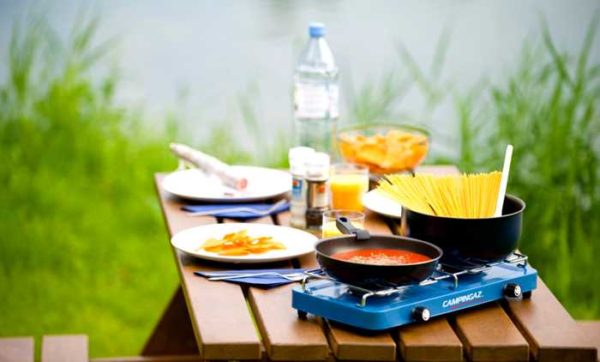
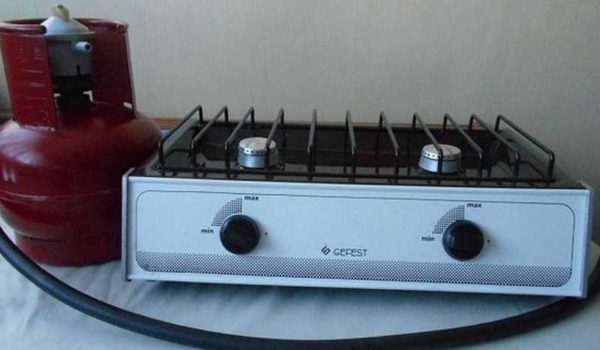
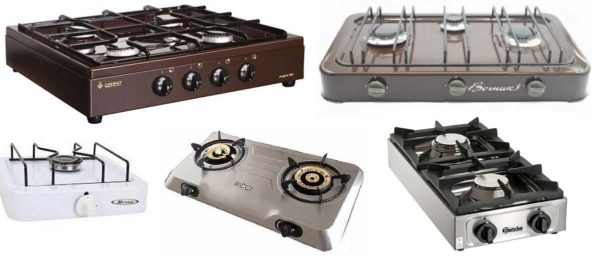
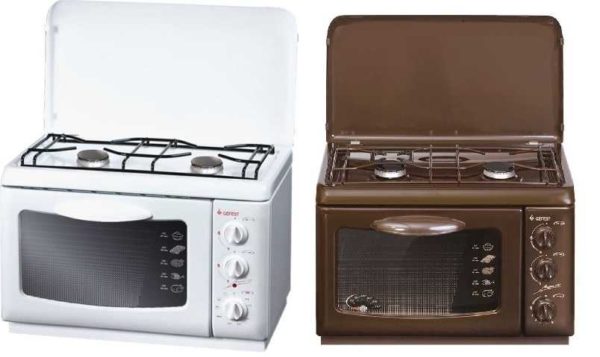
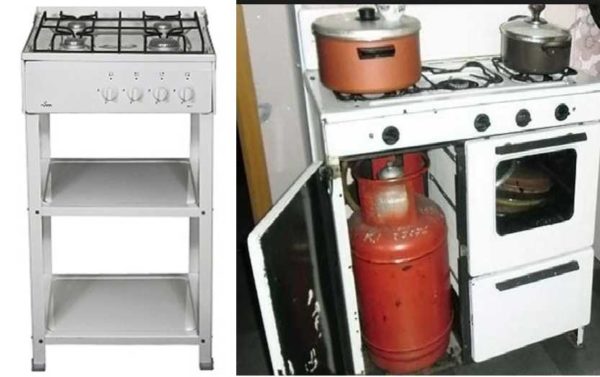
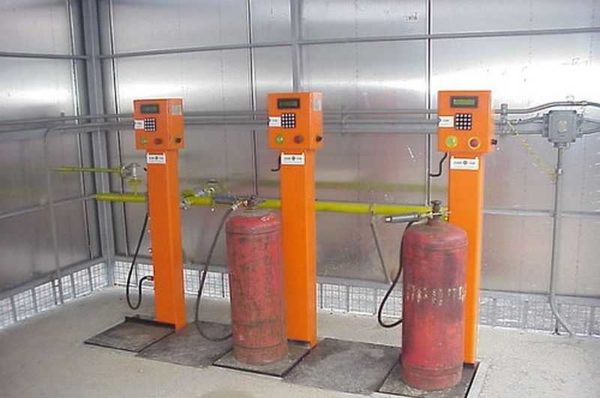

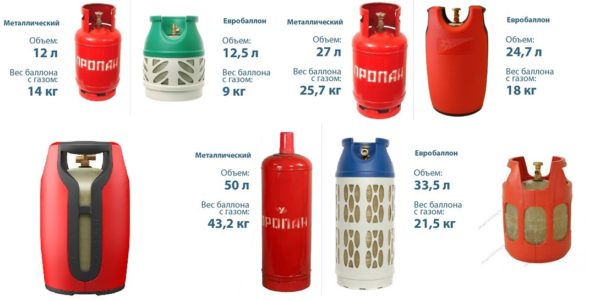

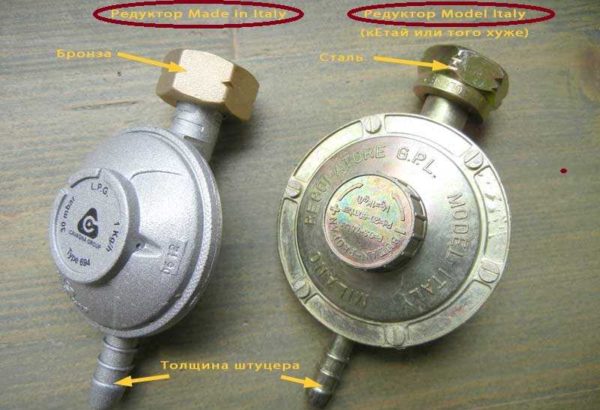
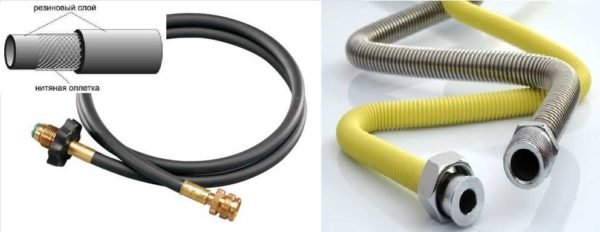
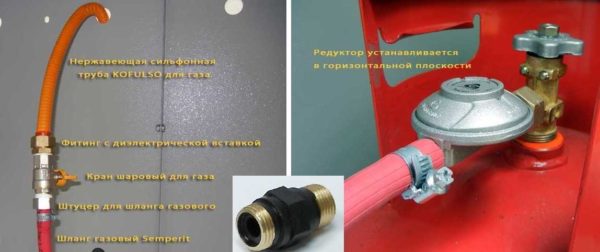
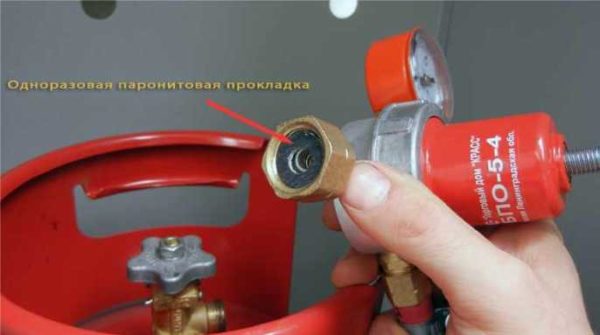










The dimensions of the two Bartscher gas stove and where can you buy it?
The site is informational, we do not sell anything.